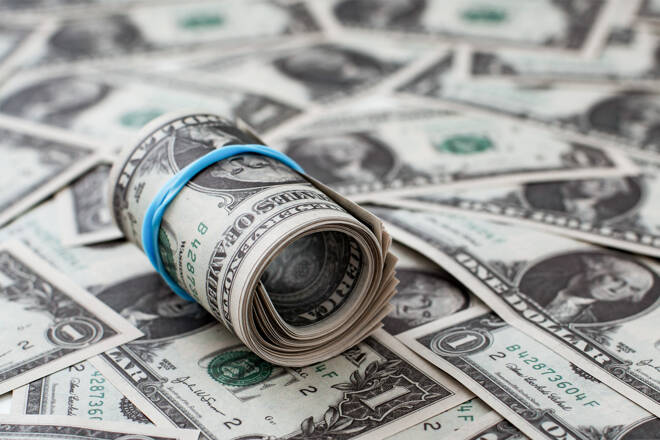Advertisement
Advertisement
US Dollar (DXY) Index News: Supported by Strong US Economy, High Rates
By:
Key Points:
- Dollar Index rises 2.7% in early 2023
- Federal Reserve likely to cut rates in June
- U.S. Treasury yields show cautious investor sentiment
Dollar Index Strengthens
The Dollar Index, a key indicator of U.S. currency strength against six major rivals, displayed an upward trend on Friday. Notably, it rose 0.3% on Thursday post-inflation data release, cumulatively gaining 2.7% over January and February. This uptick reflects a heightened investor sentiment towards the U.S. dollar.
At 14:41 GMT, the U.S. Dollar Index is trading 104.164, up 0.018 or +0.02%.
Inflation and Federal Reserve’s Response
Recent data unveiled that U.S. inflation, as gauged by the Federal Reserve’s preferred Personal Consumption Expenditures (PCE) index, aligned with market expectations in January. However, the annual inflation rate dropped to its lowest in three years. This data has significantly influenced traders’ expectations, with the probability of a Federal Reserve rate cut in June escalating to approximately 67%, as per CME’s FedWatch tool.
U.S. Treasury Yields and Economic Outlook
The U.S. Treasury yields remained relatively stable, indicating a cautious approach from investors amidst the release of pivotal inflation data. The market is closely observing inflation trends and economic indicators to gauge the future course of Federal Reserve’s monetary policies.
PCE Index Findings
The PCE index results showed a monthly increase of 0.3% and an annual rise of 2.4% in January. The core PCE, excluding food and energy, ascended by 0.4% monthly and 2.8% annually. These figures, slightly lower than December’s, still exceed the Fed’s 2% target range, suggesting sustained inflationary pressures.
Federal Reserve’s Stance and Rate Cut Projections
Federal Reserve officials, including Atlanta Fed President Raphael Bostic, have expressed a cautious stance regarding premature rate cuts, emphasizing data-driven decision-making. The consensus among several officials hints at expected rate reductions this year, although the timeline remains uncertain.
Yen Depreciates Against Dollar
The Japanese yen weakened against the dollar, influenced by Bank of Japan Governor Kazuo Ueda’s remarks on sustaining inflation levels. The dollar’s performance against the yen marked a significant increase, with the Japanese currency nearing its lowest levels since 1990.
Euro’s Steady Movement
The euro exhibited minimal change, trading at approximately $1.0807. Despite the slight deceleration in eurozone inflation to 2.6% in February, the euro has maintained a stable range against the dollar, reflecting ongoing uncertainties regarding monetary policy shifts in both the ECB and the Fed.
Short-term Market Forecast: Bullish
Considering the robust performance of the dollar, the anticipation of a Federal Reserve rate cut, and the steadiness of the U.S. Treasury yields, the short-term outlook for the U.S. currency appears bullish. This sentiment is reinforced by the market’s expectation of continued Federal Reserve intervention to stabilize inflation and support economic growth.
Technical Analysis
The US Dollar Index is edging higher for a fourth straight session on Friday, clearly establish key support at the 200-day moving average at 103.741.
The short-term range is 104.976 to 103.434. This makes its retacement zone at 104.205 to 104.386 the first upside target. Trader reaction to this 50% to 61.8% area will determine the near-term direction, essentially, bullish over 104.386 and bearish under 104.205.
About the Author
James Hyerczykauthor
James Hyerczyk is a U.S. based seasoned technical analyst and educator with over 40 years of experience in market analysis and trading, specializing in chart patterns and price movement. He is the author of two books on technical analysis and has a background in both futures and stock markets.
Advertisement
